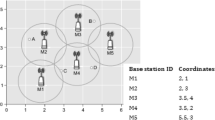Abstract
Wireless multi-hop networks have a solidarity property, in which each multi-hop link interferes mutually and so an increase in one link’s rate results in a decrease of the other links’ rate. In a multi-hop link, the end-to-end throughput between a source and destination is restricted by the lowest link rate, so the max-min fair allocation on the link rates is an optimal strategy to maximize the end-to-end throughput. In this paper, we verify that if the wireless links have a solidarity property, the max-min fair allocation has all link rates equal, so we propose a transmit power control (TPC) algorithm that decides the transmit power of multi-hop nodes to equalize all link rates. The proposed algorithm operates in a distributed manner, where each node averages the recognized link rates around itself, allocates its transmit power to achieve this average rate, and iterates this operation until all link rates become equal. Intensive simulation shows that the proposed TPC algorithm enables all link rates to converge on the same value, and thus maximizes the multi-hop end-to-end throughput while decreasing the power consumption of multi-hop nodes.








Similar content being viewed by others
Notes
Note that the rate and SINR can be converted to each other.
The full-duplex relay can decrease the per-hop processing delay, and thus increase the multi-hop end-to-end rate. However, this relay type generates more interference among links, and thus makes the proposed TPC algorithm more effective.
References
OUTLOOK: Visions and research directions for the Wireless World, WWRF (World Wide Radio Forum). http://www.wireless-world-research.org. Accessed July 2009.
Parissidis, G., Karaliopoulos, M., Spyropoulos, T., & Plattner, B. (2011). Interference-aware routing in wireless multihop networks. IEEE Transaction on Mobile Computing, 10(5), 716–733.
Jung, E.-S., & Vaidya, N. H. (2002). Power Control in Multi-Hop Wireless Networks. Technical Report.
ElBatt, T., & Ephremides, A. (2004). Joint scheduling and power control for wireless ad-hoc networks. IEEE Transactions on Wireless Communications, 3(1), 74–85.
Muqattash, A., & Krunz, M. M. (2004). A distributed transmission power control protocol for mobile ad-hoc networks. IEEE Transactions on Mobile Computing, 3(2), 113–128.
Agarwal, S., Krishnamurthy, S., Katz, R. H., & Dao, S. K. (2001). Distributed power control in ad-hoc wireless networks. IEEE Personal, Indoor and Mobile Radio Communications, 2, 59–66.
Ebert, J.-P., Stremmel, B., Wiederhold, E., & Wolisz, A. (2000). An energy-efficient power control approach for WLANs. Journal of Communications and Networks, 2(3), 197–206.
Sankarasubramaniam, Y., Akyildiz, I. F., & McLaughlin, S. W. (2003). Energy efficiency based packet size optimization in wireless sensor networks. In IEEE international workshop on sensor network protocols and applications, pp. 1–8.
Maham, B. & Hjorungnes, A. (2010). Near-optimum power allocation for BER restricted multihop cooperative networks. In IEEE international conference on, communications, pp. 1–5.
Poojary, N., Krishnamurthy, S. V., & Dao, S. (2001). Medium access control in a network of ad hoc mobile nodes with heterogeneous power capabilities. IEEE international conference on communications (Vol. 3, pp. 872–877).
Narayanaswamy, S., Kawadia, V., Sreenivas, R. S., & Kumar, P. R. (2002). Power control in ad-hoc networks: Theory, architecture, architecture, algorithm and implementation of the COMPOW protocol. European Wireless 2002.
Behzad, A., & Rubin, I. (2006). High transmission power increases the capacity of ad hoc wireless networks. IEEE Transactions on Wireless Communications, 5(1), 156–165.
Radunovic, B., & Boudec, J.-Y. Le. (2004). Rate performance objectives of multihop wireless networks. IEEE Transactions on Mobile Computing, 3(4), 334–349.
Le, H.-C., Guyennet, H., & Felea, V. (2007). OBMAC: An overhearing based MAC protocol for wireless sensor networks. In International conference on sensorComm, pp. 547–553.
Choi, D., & Park, D. (2012). Effective self interference cancellation in full duplex relay systems. IET Electronics Letters, 48(2), 129–130.
Technical specification group radio access network; further advancements for E-UTRA physical layer aspects (release 9). (2010). 3GPP TR 36.814 v9.0.0.
Acknowledgments
This work was partly supported by the GRRC program of Gyeonggi province [(GRRCHankyong2011-B03), Low Power Machine-to-Machine Communication and Network for Management of Logistic Center] and the Human Resources Development program (No. 20124030200060) of the Korea Institute of Energy Technology Evaluation and Planning (KETEP) grant funded by the Korea government Ministry of Trade, Industry and Energy.
Author information
Authors and Affiliations
Corresponding author
Rights and permissions
About this article
Cite this article
Choi, HH., Lee, JR. Distributed Transmit Power Control for Maximizing End-to-End Throughput in Wireless Multi-hop Networks. Wireless Pers Commun 74, 1033–1044 (2014). https://doi.org/10.1007/s11277-013-1342-2
Published:
Issue Date:
DOI: https://doi.org/10.1007/s11277-013-1342-2




